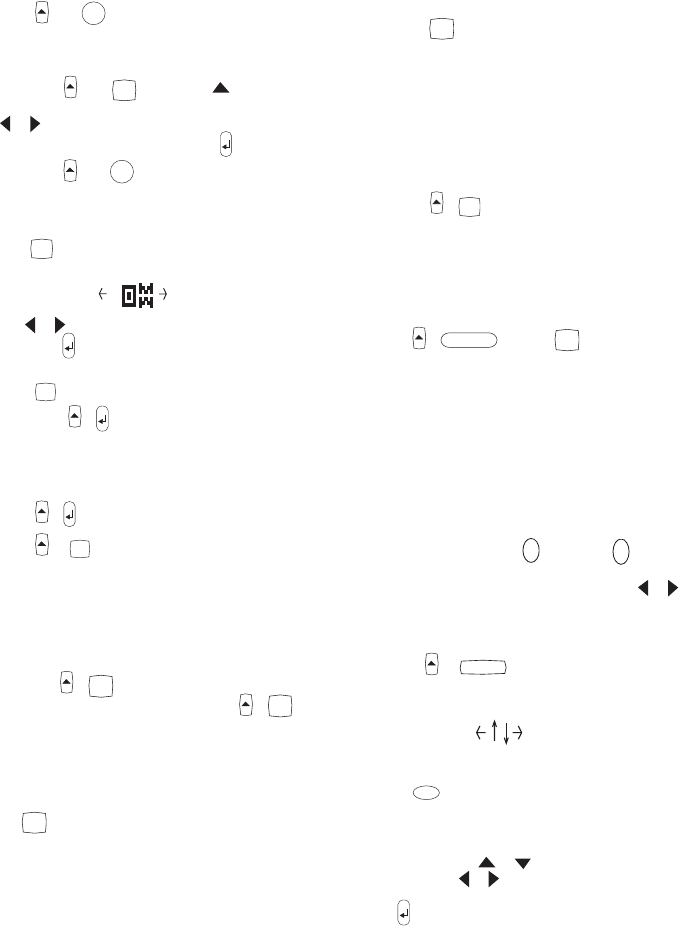
6
Press
then
PRINT
1
,
2
,
3
.
.
.
n
to continue the sequence.
• It is also possible to include auto numbering when
printing multiple copies.
• Key in your starting number, eg. LABEL 1A .
• Next press
then
STYLE
COPIES
followed by until the
desired number of copies are displayed, eg.10, or use
or to move the cursor under the number digits
and key in the number required. Press
to confirm.
Now press then
PRINT
1
,
2
,
3
.
.
.
n
. This will print ten labels -
LABEL 1A to LABEL 10A. While using fixed length
setting, the LabelPOINT will stop printing when the
label exceeds the fixed length.
STYLE
STYLE
• Press to display the style menu:
Z
Use or to select
italic
, outline or mirrored text,
then press
to confirm. The indicator for the selected
style will light in the display.
• Press
STYLE
again to cancel and return to normal text.
PAGE BREAK +
You can divide your label into 'pages' or blocks of text,
each with its own text size and style settings. The number
of lines which can be created in each page will depend on
the label width.
• Press
+ to insert a page break.
• Press
+
CAPS
PREVIEW
to preview the label; each page break
is identified by the symbol •||•.
LAST LABEL MEMORY
• The unit will store the last label text and settings when
turned off. Upon power-up, these will be restored and
displayed. Removal of the batteries for more than a few
seconds may cause this information to be lost.
ALIGNMENT +
LTH
ALIGN
• If a fixed label length is set, each press of +
LTH
ALIGN
will
align the image to the left, the center or the right of the
label, as shown in the display.
TAX FUNCTION
The LabelPOINT can be set to perform a simple sales tax
function.
When
+TAX
is selected, the label is scanned from right to
left for a valid number which is assumed to be a value net
of tax. The first occurence of a comma (,) or a full stop
(.), reading from right to left, will be read as a decimal
point. For example:
• If set to add 8.5% tax (see ‘Tax Set-up’ below),
pressing
+TAX
will calculate the tax and add it to the end
of the label:
‘Sale 10,00/’ becomes ‘Sale 10,00/10.85’
or
‘Sale 10,00 inc. tax’ becomes ‘Sale 10,00 inc. tax 10.85’
If the original number is at the end of the label, it will
be replaced by the inc. tax value:
‘Sale 10.00’ becomes ‘Sale 10.85’
• Pressing
+
+TAX
–TAX
will treat the value as inclusive of tax
and convert it to a net value:
‘Sale 10.85’ becomes ‘Sale 10.00’
or
‘10.85 excl. tax:’ becomes ‘10.85 excl. tax: 10.00’
TAX SET-UP
• Press
+ and then
+TAX
. The display will
show the previously selected tax rate, eg:
8.5%
Note: The value defaults to 1% if unset.
• Enter the rate required as XXyXX (X is a number 0-9
and y is a comma ‘,’ or full stop ‘.’).
Symbols and special characters
INTERNATIONAL CHARACTERS
To add a diacritical (accent) to create an international
character, enter the character first, followed immediately
by the diacritical, e.g. press
E
followed by
/
to
get é.
To add a diacritical to an existing character, use
or
to place the cursor under the character to the right of the
character to be changed, then press the appropriate
diacritical key.
SYMBOLS
+
SYMBOLS
• Press to show symbols and special characters, some of
which are not available direct from the keyboard. The
display will show the last used symbol character, for
example:
A1
with a line of symbols above
it. Each letter selects a line of symbol characters,
numbered 1 to 6, as shown in the table on page 2.
• Press
DEL
to cancel, or
• Press a letter key ‘A’ to ‘Z’ until you find the line of
symbols required. You can then press a number key ‘1’
to ‘6’ to select the symbol required.
Alternatively, use
or to step through the rows A
to Z, then use
or to move the cursor under the
symbol required.
Press
to place the symbol in the label.








